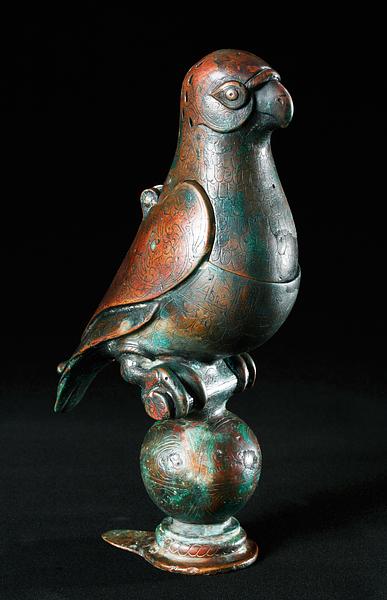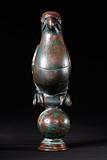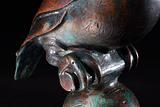Incense burner, cast, punched, and engraved bronze
Sicily or southern Italy; end of 11th – beginning of 12th century
H: 35.5 cm
This incense burner in the form of a stylized but well-modeled parrot or falcon belongs to a small group of bronze sculptures that can be ascribed with a fairly great degree of probability to Sicily or southern Italy in around 1100.
The bird is holding on with strong claws to a perch across a sphere that might have been placed on a tall pedestal. The beautifully shaped head can be lifted to gain access to the inside of the bird. Three protrusions once supported a grating, now missing, for charcoal and the incense whose fragrance was released through 33 drop-shaped perforations. The bird’s entire body is engraved with feathers, elegant curved palmettes, and a Kufi inscription.
Inv. no. 10/2005
Published in:
Sotheby’s, London, 19/10-2005, lot.293;
Susan Moore: “The Art Market, trotting all the way to the bank” in Apollo, 161, 2005, pp. 104-105;
Joachim Meyer: “The body language of a parrot: an incense burner from the Western Mediterranean” in Journal of the David Collection, 4, 2014, pp. 26-41, figs. 1 and 5-8;
Daniel C. Waugh: "The David Collection: Journal of the David Collection. 4" in The Silk road, 2014, 12, Featured museum, I: fig. 1;
Joachim Meyer: Sensual Delights: Incense Burners and Rosewater Sprinklers from the World of Islam, The David Collection, Copenhagen 2015, cat.no. 2;
Julian Raby: “The inscriptions on the Pisa Griffin and the Mari-Cha Lion : from banal blessings to indices of origin” in Anna Contadini (ed.): The Pisa griffin and the Mari-Cha lion : metalwork, art and technology in the medieval islamicate Mediterranean, Pisa 2018, pp. 305-360;
Elizabeth C. Kelly: Zoomorphic incense burners of Medieval Khurasan: a study of Islamic metalwork, Oxford 2024, fig. 7.16A;



